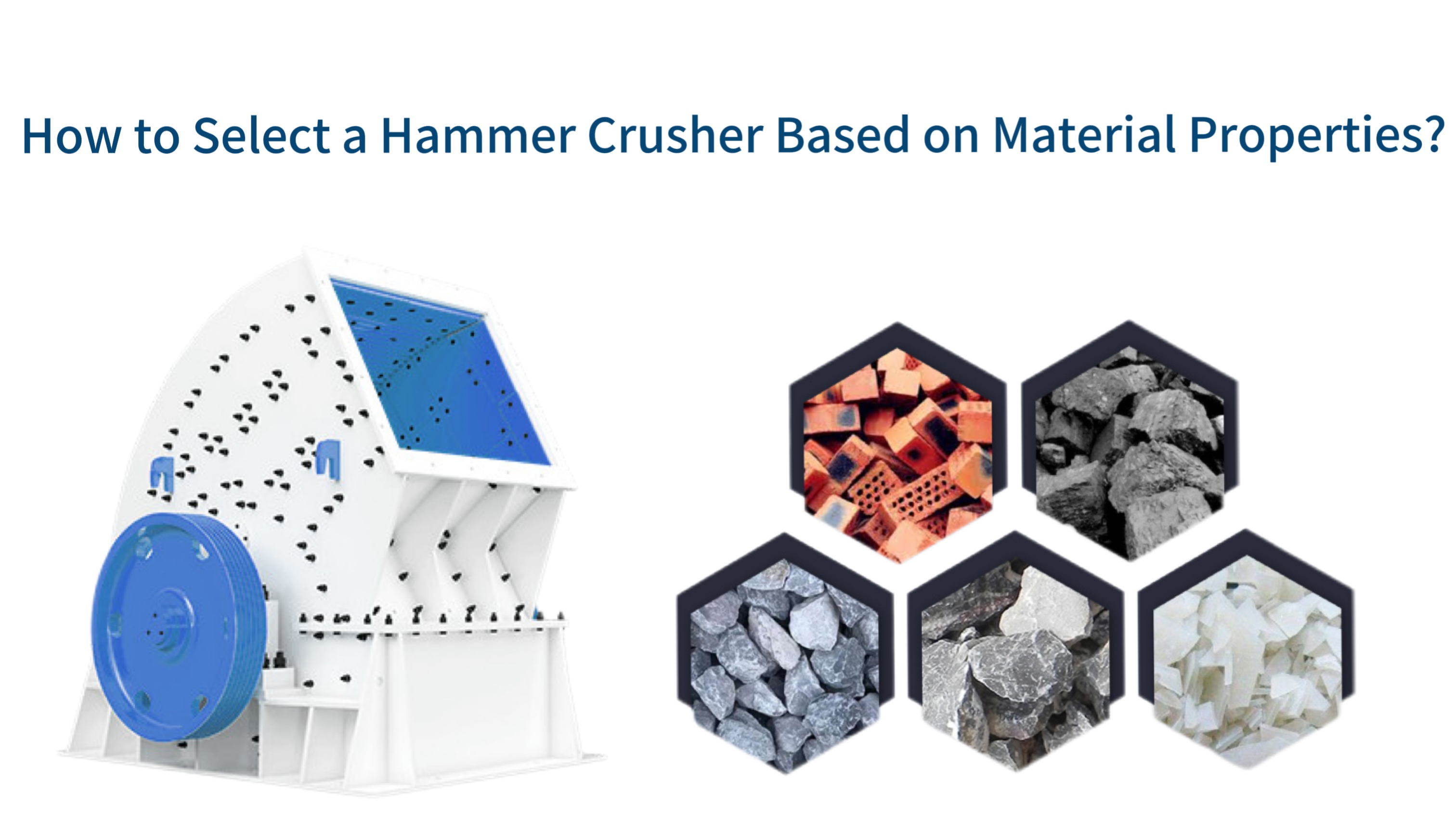How to Select a Hammer Crusher Based on Material Properties?

Choosing the right hammer crusher requires matching machine capabilities to material characteristics. This comprehensive guide examines how rock hardness, moisture content, abrasiveness, and particle size dictate equipment configuration. Discover how strategic component selection and operational adjustments optimize crushing efficiency while extending service life across diverse industrial applications.
Material Hardness Classification and Crusher Compatibility
Rock hardness fundamentally determines impact energy requirements and component wear patterns. Materials below Mohs 3 like soft limestone fracture easily with standard configurations, while quartz-rich granite demands specialized impact solutions. Understanding hardness parameters prevents premature wear and inefficient energy consumption.
Mohs Hardness Scale Applications
The Mohs scale provides crucial reference points for crusher selection. Materials between 1-3 (gypsum, limestone) require minimal impact energy, allowing higher rotor speeds. Harder materials (7-9 Mohs) like basalt demand heavy-duty hammers with tungsten carbide tips. Each hardness level increases energy consumption by approximately 18-22% compared to softer counterparts.
Compressive Strength Considerations
High compressive strength materials necessitate reinforced crushing chambers. Rocks exceeding 200 MPa compressive strength require thicker side plates and manganese steel liners. Impact-resistant alloys in hammer heads withstand repeated high-energy collisions without deformation, maintaining crushing efficiency throughout the wear cycle.
Hard Rock Processing Techniques
Granite and trap rock benefit from multi-stage reduction systems. Primary jaw crushers pre-condition material before hammer crushing. Gradient hammer arrangements concentrate impact forces where needed most, while hydraulic gap adjustment maintains consistent output despite progressive wear.
Moisture Management Strategies
Material moisture content dramatically affects crusher performance. Beyond 8% moisture, clogging risks increase exponentially as damp particles adhere to internal components. Strategic design modifications prevent efficiency losses in humid environments and wet material processing.
Critical Moisture Thresholds
The 8% moisture threshold marks where screening efficiency decreases by 35-40%. Materials exceeding this level require specialized grate designs with expanded discharge openings. Moisture sensors coupled with automatic feed rate controllers maintain optimal throughput when processing variable-content materials.
Anti-Clogging Solutions
Polyurethane-coated screens resist material adhesion in high-humidity conditions. Ventilated hammer designs with through-holes prevent material buildup on impact surfaces. Rotating brush systems continuously clear grate openings, maintaining unimpeded material flow during extended operation.
Integrated Water Management
Pre-screening feeders with drainage channels separate excess moisture before crushing. Closed-loop water recycling systems collect and filter process water, reducing consumption by 80%. These integrated solutions enable efficient wet material processing without environmental impact.
Abrasiveness Analysis and Wear Protection
Material abrasiveness directly determines component service life. Highly abrasive quartzite can wear standard hammers within 60 operating hours, while less abrasive materials permit extended use. Understanding abrasion indices guides optimal material selection and maintenance planning.
Abrasion Testing Methodology
Standardized Cerchar testing quantifies material wear potential. Rocks scoring above 4.0 on the abrasion index require premium alloys. Test results dictate hammer metallurgy choices, with high-chromium cast iron extending service life 2.3x compared to standard manganese steel in severe applications.
Advanced Wear Materials
Ceramic-insert composite hammers offer exceptional abrasion resistance. These hybrid components feature replaceable ceramic tips brazed onto steel bodies, providing hardness exceeding 70 HRC. Though 40% more expensive initially, they deliver 300% longer service life in high-abrasion environments.
Strategic Wear Distribution
Rotating hammer positions equalizes wear patterns. Progressive hammer arrangements place newer components in high-wear zones. This systematic rotation extends overall set life by 45% while maintaining consistent product gradation throughout the wear cycle.
Feed Size Optimization Principles
Optimal feed dimensions ensure efficient energy transfer. Oversized material causes bridging and hammer rebound, while undersized feed reduces impact effectiveness. Proper sizing prevents component stress and improves product quality.
Feed Opening Ratios
The 1:3 ratio between maximum feed size and rotor diameter ensures efficient impact transfer. Larger feed openings accommodate irregularly shaped materials like demolition concrete. Variable-speed feeders regulate material flow, preventing surges that cause component overload.
Pre-Crushing Benefits
Primary reduction stages condition feed material for optimal hammer crusher efficiency. Jaw crushers pre-process oversized rock, creating uniform feed that increases hammer crusher throughput by 25-30% while reducing specific energy consumption.
Chamber Geometry Selection
Deep crushing chambers accommodate large feed stocks, providing extended material retention for complete fragmentation. Curved impact plates create secondary fracture zones, improving cubical product formation. Adjustable breaker plates fine-tune particle trajectory for maximum impact efficiency.
Specialized Material Processing
Unique materials demand customized engineering solutions. Frozen aggregates, metal-contaminated streams, and hazardous substances require specialized configurations beyond standard crusher designs.
Low-Temperature Processing
Arctic operations employ heated feed hoppers preventing material freezing. Insulated crusher housings maintain operational temperatures down to -40°C. Impact-resistant steel alloys maintain toughness in extreme cold, preventing brittle fracture of critical components.
Metal Contamination Solutions
Integrated metal detectors trigger instant shutdown when detecting tramp iron. Reversible rotors minimize damage from occasional impacts. Magnetic head pulleys remove ferrous contaminants from feed material, protecting downstream processing equipment.
Hazardous Material Handling
Explosion-proof motors and dust containment systems enable safe processing of combustible materials. Nitrogen inerting systems suppress combustion risks in confined spaces. Corrosion-resistant coatings protect against chemical degradation when processing acidic industrial byproducts.
Maintenance Adaptation Strategies
Preventive maintenance programs adapt to material characteristics. Monitoring technologies detect abnormal wear patterns early, enabling proactive component replacement before failures occur.
Predictive Wear Monitoring
Vibration analysis identifies imbalance caused by uneven hammer wear. Thermal imaging detects abnormal bearing temperatures indicating lubrication issues. These technologies enable maintenance scheduling during planned downtime, reducing unexpected outages by 70%.
Automated Lubrication Systems
Centralized lubrication delivers precise grease quantities to critical wear points. Moisture-resistant greases maintain viscosity in humid environments. Filtration systems remove abrasive particles from lubricants, extending bearing life in high-contamination applications.
Performance Data Integration
Material databases track wear rates across different rock types. Historical performance data informs future component selection and maintenance intervals. Digital twins simulate new material processing, predicting wear patterns before physical trials.